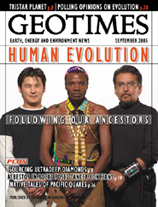
|
|
||||||||||||||
| |
|||||||||||||||
|
Tristar planet Sourcing ultradeep diamonds Rocks pose cancer concerns Supercomputer models Earth's magnetic field Repositioning Tokyo's fault Footprints push back American migration Shrinking and growing Arctic lakes Seabird guano changes the Arctic Discovery returns to flight Geophenomena
Print Exclusive |
||||||||||||||
|
Believing vs. Knowing: Faith’s Role in the Evolution Debate In a sea of religious and political extremes, people face unnecessary strife in reconciling scientific evidence for evolution with their faiths. Lee J. Suttner Political Scene Congressional Climate: Changing or Chilling? A confrontation between some congressional members and climate scientists this summer highlights some of the dangers of politicizing science. Linda Rowan Geologic Column Seventeen Places Expand your “must-visit” list to geologically unique and unforgettable places. Lisa Rossbacher |
Paul Bierman: New landscapes for teaching Geomedia
|
||||||||||||||
 ON
THE COVER ON
THE COVER The Genographic Project, co-sponsored by the National Geographic Society, IBM and the Waitt Family Foundation, is genetically sequencing DNA from thousands of people around the world to track individuals' migration out of Africa. The focus of the project is on indigenous people, such as those pictured here: Battur "Turo" Tumur, a descendant of Mongolian leader Genghis Khan who lives in San Francisco, Calif.; Julius Indaaya Hun/!un//!ume, the Hadzabe chieftain in Tanzania; Phil Bluehouse Jr., a Navajo Indian from Arizona. Read the story on page 24. Photo by Mark Thiessen, National Geographic. |
October: Global Resources
|
| SUBSCRIBE | CLASSIFIEDS | ADVERTISE | FOR AUTHORS | CONTACT US | ARCHIVES | SEARCH |
 |
Geotimes Home | AGI Home | Information Services | Geoscience Education | Public Policy | Programs | Publications | Careers |